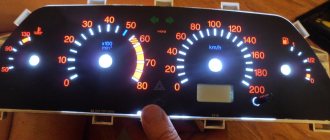We will organize polite lighting in the salon according to a simple scheme for 2022
The safety of driving a car depends on the convenience and comfort inside the cabin. A special role is played by high-quality external and internal lighting, which should not tire the eyes of the driver and passengers, effectively performing its function.
The car owner himself can improve the quality of light inside the cabin without any problems. You can make a so-called dimmer with your own hands using a simple circuit. The finished product is also available in automotive stores.
What are the differences between dimmers?
If you are going to use a switch with brightness control, you first need to find out what they are. And in general, can all LED lamps be dimmed?
Dimmers differ according to the following criteria:
- By type of installation;
- on execution and method of management;
- according to the method of regulation.
Let's take a closer look at each of them.
By installation type
For outdoor installation – surface-mounted switch with dimmer for LED lamps. To install such a device, you do not need to drill a niche in the wall; it is simply mounted on top of the wall. It is very convenient to use in cases where the interior is not a priority or external wiring is installed.
For indoor installation - they will fit perfectly into any interior, such as this one.
For DIN rail mounting they are very specific and at first it may seem that they are not practical. However, this dimmer for LED lamps works with a remote control, and is hidden from prying eyes in the electrical panel.
By execution
According to the design, the light controller for LED and incandescent lamps can be:
- Rotary;
- rotary-push type;
- push-button;
- sensory;
Rotary is one of the simplest options for dimming an LED lamp; it looks unpretentious and has the simplest functionality.
The turn-and-push one looks almost the same as the rotary one. Thanks to its design, when you press it, the light turns on with the same brightness as it was set the last time you turned it on.
A push-button controller for LED lighting looks more technologically advanced and will fit seamlessly into a modern apartment. Like this switch with a dimmer for LED lamps.
Touch models can be completely different - from luminous circles to smooth single-color panels for adjusting the voltage of LED lamps.
According to the adjustment method
Dimmers vary not only in their design, but also in their operating principle. This applies specifically to AC dimmers.
The first type of dimmer is more common and cheaper, due to the simplicity of its circuit - a leading edge cutoff dimmer. A little further on, its operating principle and circuit will be discussed in detail; for comparison, take a look at the type of voltage at the output of such a regulator.
The graph shows that the remainder of the half-wave is supplied to the load, and its beginning is cut off. Due to the nature of the load switching on, interference is generated in the electrical networks, which interferes with the operation of televisions and other devices. A voltage of the set amplitude is applied to the lamp, and then it fades out when the sine wave passes through zero.
Can a leading edge dimmer be used for LED lamps? Can. LED lamps with a dimmer of this type will only be well adjustable if they were originally designed for this. This is evidenced by the symbols on its packaging. They are also called “dimmable”.
The second type works differently, creates less interference and works better with different light bulbs - this is a falling edge dimmer.
LED lamps with this type of dimmer adjust better, and its design better supports non-dimmable light sources. The only drawback is that these lamps can adjust their brightness not from “zero”, but within a certain range. At the same time, dimmable LED lamps are simply superbly adjustable.
A special word can be said about ready-made LED lamps with adjustable brightness. This is a separate class of lighting devices that do not require the installation of additional regulators, but have them in their design. Their adjustments are made using buttons on the case or from the remote control.
How to make a device with your own hands
By adopting a simple universal scheme, almost every car owner can make polite lighting with his own hands.
For work you will need the following parts and materials:
After completing all installation work, you must check the resulting device.
Most often, the structure is filled with a silicone fixative or high-temperature-resistant glue. In this state, it can be installed directly inside the lampshade.
In addition, the system can be powered from the cigarette lighter by attaching light sources under the trim at various points in the cabin. Using LEDs, you can effectively illuminate various areas and elements of the salon interior.
Bonus. Reader question about the sensor on LP8072C
Let's look at the circuit of a motion sensor on a specialized LP8072C chip, which was sent by reader Andrey (see comment to the article dated December 15, 2015)
Sensor circuit for LP8072C
I repeat his question again and answer:
Yes, the circuit is divided into two boards, as in the sensor at the beginning of the article. 0V – GND, on pin 5 of the microcircuit, 5V – power supply, VDD, on pin 13, and output for controlling the transistor.
Everything is correct so far. Just for fun, you can short-circuit the base and emitter of the transistor (for example, with a screwdriver, and the output 5V will drop across the 5.6 kOhm resistor, it’s not scary). The relay and load should turn off. This will indicate that the transistor and power circuits are working.
Between pins 5 and 11? This is just a power output, the voltmeter should not affect it. It turns out that the voltmeter has bypassed the output of the microcircuit, as I recommended above by shorting the base-emitter with a screwdriver. This shouldn’t happen, either the microcircuit is faulty (most likely) or the voltmeter.
Yes, this chain to reduce sparking of relay contacts does not play a role in this case.
I recommend changing the microcircuit. But first, study the case when a measurement was taken and the sensor worked. The fact is that the input resistance of a voltmeter during measurement affects the circuit, and it is better if it is larger. Typically, the input resistance is about a hundred kiloohms, but cheap models can have 20...50 kOhms (depending on the measurement limit). Therefore, take a resistor of about 100 kOhm, or a little less, and connect it in parallel with the output of the microcircuit. Or between the base and emitter of the transistor.
Such a resistor must be built inside the microcircuit, or it is placed between the base and emitter of the transistor, to increase operational reliability. As in the light sensor circuit.
And the microcircuit is most likely faulty (partially), or has left the mode due to external wiring.
Photo of the spotlight and motion sensor, Andrey sent:
Floodlight with motion sensor on LP8072C
Motion sensor on LP8072C
Motion Sensor. Power board
Scheme and principle of its operation
The schematic diagram of polite lighting is shown in the figure.
Its executive body is an 8-bit ATtiny13 microcontroller with programmable flash memory with a capacity of 1 kB. It features low current consumption and a wide supply voltage range (1.8–5.5 V). This circuit is powered from a battery (+12 V). On the ATtiny13 MK (the voltage output comes after a rectifier diode (reversal protection) and a 5 V stabilizer assembled on an LM7805 and two smoothing capacitors. The output signal is taken from pin 5, which is then supplied to an n-channel MOSFET.
It features low current consumption and a wide supply voltage range (1.8–5.5 V). This circuit is powered from a battery (+12 V). On the ATtiny13 MK (the voltage output comes after a rectifier diode (reversal protection) and a 5 V stabilizer assembled on an LM7805 and two smoothing capacitors. The output signal is taken from pin 5, which is then supplied to an n-channel MOSFET.
Printed circuit board
The design development of the product is presented in the form of a printed circuit board podsvetka.lay, which is available for Layout versions 5.0 and 6.0. The courtesy backlight board is made in a single-sided version and, despite its compact dimensions (18*28 mm), is easy to assemble with your own hands. Resistors, capacitors and diodes are SMD components of standard sizes 0805 and 1206. The transistor AP60T03AH (Imax=45 A, Uс=30 V) is installed in a TO-252 housing with a drain on the radiator. The ATtiny13 MCU is used in an 8-pin SOIC package.
Connection options
The polite lighting in question can be connected in two ways to the car’s interior lighting. The first (the simplest) does not involve changes in the electrical wiring of the lamp.
As can be seen from the figure, at the moment the limit switch is closed, the load current will begin to flow through the home-made device, launching the smooth switch-on (switch-off) circuit into operation. If the interior lighting is turned on with a stationary switch, the smart lighting circuit remains unused and the light bulb will be on constantly.
The technical implementation of the second method involves reworking the lampshade.
The load current flow circuit is broken at negative. The negative contact of the light bulb is connected to the drain of the transistor, and the wire from the stationary switch is connected to the cathode of the diode. As a result of this connection, the glow of the lamp can be controlled both from the limit switch and from the standard switch.
Prospects for the use of lamps
Traditional light bulbs, which are now banned in many countries, could be making a comeback thanks to a technological breakthrough. Incandescent light bulbs, developed by Thomas Edison, produce light by heating a thin tungsten filament to a temperature of 2,700 degrees Celsius. This hot wire emits energy known as black body radiation, which represents a very wide spectrum of light, providing not just a warm light, but also the most accurate reproduction of all known colors of the universe. However, they have always suffered from one serious problem: more than 95% of the energy that goes into them is wasted as thermal energy.
Now, researchers from MIT and Purdue University have found a way to restore their former popularity and promise to create new MIT lamps with the efficiency of LEDs. It will work by placing nano-mirrors around a conventional element, which will return wasted heat back to produce light in the efficiency range of LED and fluorescent lamps.
The lamp element is surrounded by a system of nano-photonic mirrors on the cold side, which transmit visible light. But they reflect heat from infrared radiation. This heat is then absorbed by its element, causing it to emit more light. This original trick is very simple and viable. The tungsten element has also been changed - MIT uses tape instead of filament, which is better for absorbing reflected heat. The experiment, carried out by physicists Ognin Ilik, Marin Soljacic and John Joannopoulos, has already managed to triple its efficiency to 6.6%.
Scientists are confident that they can achieve 40% efficiency, which is at the upper limit of what is possible for any light source. Modern LEDs still reach the level of 15%.
And if scientists fulfill their ambitious promises, traditional lamps will deservedly rise from oblivion. Then smooth switching on and off of the light will be ensured by their design.
Why is it convenient to use smart light?
The use of smart light gives not only an aesthetic, but also a purely technical effect. Such lighting is well perceived visually, provides those inside the cabin with good psychological relief due to the light that is pleasant to the eyes, and at the same time performs several additional technical functions. For example, it eliminates such a “trifle” that irritates many people, such as the sudden turning off of the light inside the cabin immediately after closing the door, that is, the time of its illumination is extended. This is done using a special electronic board, which is mounted in the car’s lighting system according to a special scheme, which is not difficult to find.
Where to start repairs if the sensor does not work
These arguments and methods of mine apply not only to a specific motion sensor, but also to many electronic devices. For example, to a light sensor, the circuit of which is much simpler, but the principle is the same.
1. Check that the connection is correct. At this stage, you also need to find out why the motion sensor does not work and under what circumstances. Options (brainstorming):
- leap of light,
- turned off the electricity
- construction work,
- an electrician came to the neighbors,
- some kind of smell
- the children were spinning
- hit
- the dog chewed
- neighbors flooded
- there was wind yesterday
- sometimes it didn't work well
- etc.
At this stage, it is already possible to identify the direction in which to move further.
You need to check that the connection is correct, make sure that the sensor is receiving the correct power, and if there are indicators, they should be on. Some. Sometimes. Next, simulate a situation in which it should work.
2. Correct adjustments. The regulators may be installed incorrectly, and it is enough to adjust the sensor correctly. To do this, it is necessary to put the controls in positions in which it is most likely to turn on: Set the illumination level to a position at which the sensor will operate both day and night. Set sensitivity to maximum. Set operating time to minimum. In any case, it’s worth turning the controls and analyzing how the sensor behaves and whether it reacts at all.
The process of repairing the chandelier control unit
The problem with the faulty controller was that more than one relay would not turn on. And sometimes one relay might not turn on. That is, if one more relay can be turned on, then the second and especially the third are no longer turned on.
To repair, you first need to make sure that the remote control is working (the batteries are normal, and when you press any button on the remote control, the indicator lights up), and supply power to the controller:
We connect the controller to carry out measurements and checks during the repair process
I connected the power through the Vago terminals, it is very convenient. I inserted both wires N (black) into the terminal block, although either one is enough. The fact is that I do not connect the load, and wire N, if it dangles, can short-circuit to the output phase wires. The presence of output voltages can be checked by connecting 3 load lamps. But you can do it simpler - check the presence/absence of phase at the outputs with a phase indicator.
For convenience, I recommend that you connect our device not through a Vago, but through a two-pole circuit breaker, so as not to plug it into a socket; it’s more convenient to turn it on/off. Denomination – the lower the better.
First of all, we check the supply voltage. We measure with a conventional multimeter, switched to constant voltage mode, on the electrolytic capacitor of filter C3. In relation to the common wire (minus the diode bridge and capacitors C3, C4, as is more convenient).
The voltage when the relays are turned off (almost no load, idle) on the filter capacitor is 11.2V; when any of the relays is turned on, it drops to 6V. At this voltage, even if the decoder gives a signal to open the transistor and it opens, the relay will still not turn on.
Naturally, suspicion immediately fell on the part of the electrical circuit responsible for power supply. Namely, to the limiting capacitor C2 in front of the diode bridge.
It says 155J. This means 15x10^5 picoFarads. And since there are a million picoFarads in 1 microFarad, this means that the capacitance of the capacitor is 1.5 μF. The voltage is clear, 250V.
If its capacitance has dropped, then it greatly limits the current of the diode bridge, and under load the voltage at the bridge output (and at the input, in the first place) drops significantly.
Another possible culprit for the drawdown is the electrolytic capacitor at the output of the diode bridge 470 uF 25V.
We change the 1.5 µF capacitor.
Now we measure the voltage at the output of the diode bridge in four operating modes:
- idle: 12.9V,
- switching on one relay: 12.2V,
- switching on two relays: 11.7V,
- switching on three relays: 10.5V.
Everything works fine!
Other malfunctions of chandelier controllers are below:
What is the backlight made of?
Light-emitting diode
It is distinguished by its flexible design; it cannot be broken or torn off.
They are also quite easy to solder and there are no problems with the length of the lamps. You can place individual diodes anywhere in the cabin, and in some categories of such lamps it is possible to change their color. However, they are somewhat more expensive than others - neon lamps
. In addition, it is noted that neon can last much longer.
Before you start working, you must understand for yourself whether you can do it yourself. If you feel even the slightest bit of self-doubt, it is better to turn to specialists. Because it will be much cheaper to pay strangers once than to change something that was done incorrectly.
If you decide to do everything yourself, then you should know some subtleties. When buying diodes on the market, you must be prepared that you will have to solder them. Therefore, it is recommended to buy ready-made products, although they will cost a little more.
LED lighting elements
Illumination, including in the leg area, can be created by various sources. Without big problems, you can implement all the varieties of known interior lighting options with your own hands.
Article on the topic: Choosing anti-slip mats for the car dashboard
The accumulated experience clearly demonstrates that such tuning provides the best results when using single and strip semiconductor light sources to illuminate the area around the legs and other places. This is determined by the fact that:
- they do not require high voltage for their operation and are powered from the vehicle’s on-board network;
- due to the low voltage, semiconductor sources are safe to use, even in the area of the feet;
- sources of this type are economical and do not create a serious load on the on-board network of the VAZ-2110;
- LED strips are very flexible and allow you to go around any contour;
- LED strips are available today in a variety of colors.
Materials used
Most often, experts advise acquiring a standard mini-set of parts, which includes five resistors with a resistance of up to 220 K, capacitors with a capacity in the range of 50–100 μF and a voltage of 16 volts, transistors of various formats, a stranded wire, an SR5100 diode, which can be purchased at any modern radio market. It goes without saying that the work will require a soldering iron, rosin and solder, which are indispensable in such cases, and the installation of the smart light itself, if you strictly follow one or another chosen scheme, will take no more than an hour. Of course, when making an innovation in the salon, it is necessary to strictly follow all technical safety rules.
Installation location of the protective block
Smooth switching on of light in an apartment is achieved by choosing the right installation location. Protection for each lamp is installed depending on its location. If technically possible, it is better to place it in the cavity under the chandelier. The advantage of the device is its compactness. Therefore, it is installed in any accessible place next to the lighting fixture.
Detailed instructions are supplied with the unit. Therefore, you can install it yourself without resorting to the services of an electrician. If the power of the UPVL allows, installation for a group of several lamps is possible. In this case, the best placement location is a junction box. If the protective circuit contains a lighting transformer to reduce power, then the unit should be located first along the current flow. The 220 V voltage should be supplied to it first, and then along the circuit to the entire lighting network.
When installing a soft-light switching device, you must adhere to strict rules:
- Availability for repairs.
- It is forbidden to cover the UPVL with wallpaper, cover it with plasterboard and seal it with plaster.











